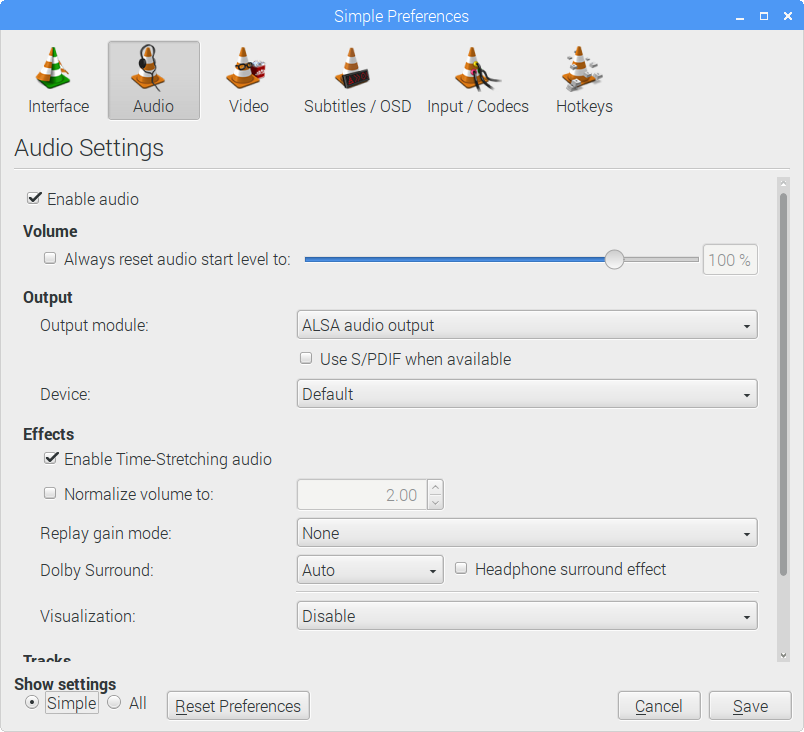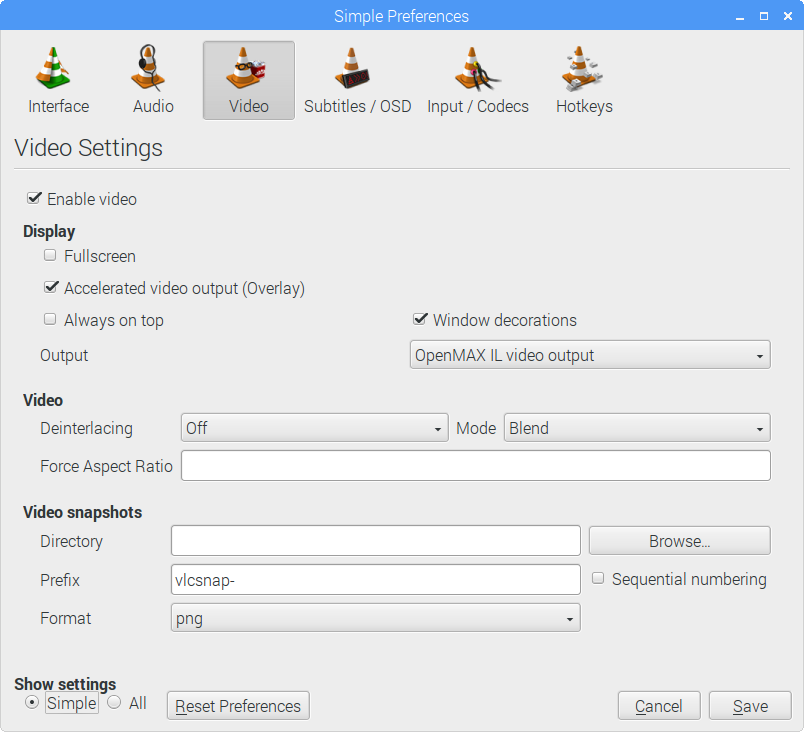How To Install Vlc Media Player In Raspberry Pi 3
VLC media player is one of the all-time options available for playing videos and more than. And people know it: a whopping 72% of respondents to a poll run by Lifehacker called VLC the best video actor available.
VLC media player is bachelor for many operating systems, including Windows, OS X, and Linux. Because Raspbian – the popular Raspberry Pi operating system – is based on Debian, one of the earliest Linux distributions, Raspberry Pi users tin can easily install VLC past opening Terminal and running the commandsudo apt-get install vlc.
Like shooting fish in a barrel, right? But here's the grab: the build of VLC media player available in Raspbian's repositories lacks OpenMAX support, and information technology'south incapable of playing video properly. So close upwards Concluding and don't enter that command to a higher place (if you already did, we'll undo information technology in a second), because we have a better plan. Here'southward how to compile VLC media thespian with hardware acceleration for the Raspberry Pi.
How to compile VLC media role player with hardware acceleration for the Raspberry Pi
Thanks to a post on the Raspberry Pi Foundation'due south message board, we have detailed instructions on how to hands compile VLC media player with hardware dispatch. For this project, you'll only need a Raspberry Pi and the basic peripherals: a ability source, screen, keyboard and mouse, and microSD card (you need all of this to get Raspbian installed in the first place, anyway).
Before nosotros begin, a quick note for those of yous who already have Raspbian and may accept installed VLC media player from Raspbian's repositories: I recommend that you remove that version. You tin do so by running the command:
sudo apt-get purge vlc
Alright, let'southward become started.
Step 1: Install Raspbian
If you don't already take it, install Raspbian on your Raspberry Pi. Click that link for our complete guide.
Stride 2: Download and excerpt VLC media player
Hop into Terminal and run the following commands:
cd Downloads wget http://download.videolan.org/vlc/ii.two.5.1/vlc-2.2.v.1.tar.xz tar -xJf vlc-2.2.5.one.tar.xz
At present yous take downloaded and extracted the latest version of VLC media player into your Downloads directory.
Pace three: Install dependencies
Next, permit'south update the package list and install the needed dependencies. You might want to copy and paste the second control here, as information technology's quite long:
sudo apt-become update sudo apt-get install autopoint gettext liba52-0.7.4-dev libaa1-dev libasound2-dev libass-dev libavahi-client-dev libavc1394-dev libavcodec-dev libavformat-dev libbluray-dev libcaca-dev libcddb2-dev libcdio-dev libchromaprint-dev libdbus-i-dev libdc1394-22-dev libdca-dev libdirectfb-dev libdvbpsi-dev libdvdnav-dev libdvdread-dev libegl1-mesa-dev libfaad-dev libflac-dev libfluidsynth-dev libfreerdp-dev libfreetype6-dev libfribidi-dev libgl1-mesa-dev libgles1-mesa-dev libgles2-mesa-dev libgnutls28-dev libgtk2.0-dev libidn11-dev libiso9660-dev libjack-jackd2-dev libkate-dev liblircclient-dev liblivemedia-dev liblua5.ii-dev libmad0-dev libmatroska-dev libmodplug-dev libmpcdec-dev libmpeg2-iv-dev libmtp-dev libncursesw5-dev libnotify-dev libogg-dev libomxil-bellagio-dev libopus-dev libpng12-dev libpulse-dev libqt4-dev libraw1394-dev libresid-builder-dev librsvg2-dev libsamplerate0-dev libschroedinger-dev libsdl-image1.2-dev libsdl1.ii-dev libshine-dev libshout3-dev libsidplay2-dev libsmbclient-dev libspeex-dev libspeexdsp-dev libssh2-one-dev libswscale-dev libtag1-dev libtheora-dev libtwolame-dev libudev-dev libupnp-dev libv4l-dev libva-dev libvcdinfo-dev libvdpau-dev libvncserver-dev libvorbis-dev libx11-dev libx264-dev libxcb-composite0-dev libxcb-keysyms1-dev libxcb-randr0-dev libxcb-shm0-dev libxcb-xv0-dev libxcb1-dev libxext-dev libxinerama-dev libxml2-dev libxpm-dev libzvbi-dev lua5.2 oss4-dev pkg-config zlib1g-dev libtool build-essential autoconf
Phew! Alright, we're ready to compile.
Step 4: Compile VLC media player
Let's hop into VLC media player's directory and run some more commands. You may want to copy and paste over again for the third i hither:
cd vlc-2.ii.5.1 ./bootstrap CFLAGS="-I/opt/vc/include/ -I/opt/vc/include/interface/vcos/pthreads -I/opt/vc/include/interface/vmcs_host/linux -I/opt/vc/include/interface/mmal -I/opt/vc/include/interface/vchiq_arm -I/opt/vc/include/IL -I/opt/vc/include/GLES2 -mfloat-abi=hard -mcpu=cortex-a7 -mfpu=neon-vfpv4" CXXFLAGS="-I/opt/vc/include/ -I/opt/vc/include/interface/vcos/pthreads -I/opt/vc/include/interface/vmcs_host/linux -I/opt/vc/include/interface/mmal -I/opt/vc/include/interface/vchiq_arm -I/opt/vc/include/IL -mfloat-abi=difficult -I/opt/vc/include/GLES2 -mcpu=cortex-a7 -mfpu=neon-vfpv4" LDFLAGS="-50/opt/vc/lib" ./configure --prefix=/usr --enable-omxil --enable-omxil-vout --enable-rpi-omxil --disable-mmal-codec --disable-mmal-vout --enable-gles2
And and so another command, which, mercifully, is a short one:
make -j3
Be prepared to wait something like xx-25 minutes.
If the process goes through, y'all will have successfully compiled VLC media histrion. The last command in our instructions installs the binaries from the building process and copies them to appropriate locations:
sudo make install
Step v: Change settings
Y'all've now compiled and installed VLC media thespian. You tin start the plan via the bill of fare bar (Audio & Video > VLC media role player) or Last (with the controlvlc). After starting the program, open the settings dialog and alter your settings (Tools > Preferences) and so that they look like this:
Sound
Output module: ALSA audio output

Video
Output: OpenMAX IL video output

When you play something, y'all'll notice that the video plays in an overlay and not within a window. You can only command the playback using your keyboard, so I would encourage you to learn some basic hot keys (for example, CTRL+Q for quitting).
Pace half dozen: Send the sound out over your HDMI connexion (optional)
There's one more than affair that you may want to tweak here before we're done. At this signal, VLC media actor will send audio out through your Raspberry Pi's headphone jack merely, meaning yous'll take to plug in headphones, an auxiliary cord to your stereo organization, or standalone speakers in order to hear your videos. That works out for some users, simply others may want to push the audio out the HDMI port.
To do that, open Terminal and run the command sudo raspi-config. In the resulting card, navigate to Advanced Options > A4 Audio > Choose the audio output: 2 Force HDMI.
And that's it! Nosotros're done hither. Yous now have a functioning version of VLC media player, and can push the audio out of either your headphone jack or HDMI port at will. If you lot ever want to remove VLC media actor, you can do and then by running the following control inside your VLC directory:
sudo make uninstall
Now go along and enjoy your videos!
Source: https://thepi.io/how-to-compile-vlc-media-player-with-hardware-acceleration-for-the-raspberry-pi/
Posted by: downinghousle.blogspot.com


0 Response to "How To Install Vlc Media Player In Raspberry Pi 3"
Post a Comment